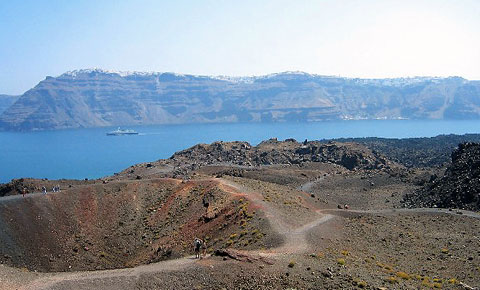The group of islands known as Santorini is unique. Santorini olarak bilinen adalar grubu benzersizdir. Probably the only volcano with a caldera that reaches into the sea, the last major explosion occurred during the Minoan Bronze Age 3,600 years ago. denize ulaştığı bir Caldera ile Muhtemelen sadece volkan, son büyük patlama 3600 yıl önce Minos Tunç Çağı sırasında oluştu. The thunderous fury of nature left its mark on the island, the home of Greece's last active volcano which still smolders today. Doğanın gök öfke, Yunanistan'ın son aktif volkanın ev halen smolders bugün adada damgasını vurmuştur. The entire center of the circular island sank into the sea during the tremendous volcanic explosion. dairesel adanın tüm merkezi büyük volkanik patlama sırasında denize battı. The eruption caused tidal waves which virtually wiped out the advanced Minoan Civilization of Crete, 70 miles to the south. Patlama hemen güneyinde 70 mil Girit, gelişmiş Minos uygarlığının sildi gelgit dalgaları neden oldu. The huge mass of pumice thrown out from the Minoan eruption covered the surface of the sea over a wide region and was washed up at higher levels on the shores by the tsunamis triggered by earthquakes. Minos patlama dışarı atılan ponza devasa kütle ve geniş bir bölge üzerinde deniz yüzeyi kaplı depremlerin tetiklediği tsunami tarafından kıyılarında yüksek seviyelerde kadar yıkandı. A recent example is the earthquake in Santorini that happened on 9th July 1956, when the tides on the island of Ios reached a height of 25 meters. Güncel bir örnek Ios adasında gelgitler 25 metre yüksekliğe ulaştı 9 Temmuz 1956 tarihinde meydana Santorini depremdir. On most of the shores of the surrounding part of the Aegean, lumps of pumice have been found that clearly drifted on the surface of the water. Ege'nin çevreleyen bölümünün kıyıları, çoğu pomza yığınları üzerinde açıkça su yüzeyinde sürüklendi tespit edilmiştir. Pumice was also found on the northern coast of Crete and on the shores of Anafi, Limnos, Paros, Samothraki, Cyprus and even Israel. Pomza aynı zamanda Girit kuzey kıyısında ve Anafi, Limnos, Paros, Samothraki, Kıbrıs ve hatta İsrail kıyısında bulundu. Experts have discovered traces of this eruption as far as Egypt on the Nile Delta. Uzmanlar bu patlama izleri kadar Mısır olarak Nil Deltası üzerinde keşfettim.
What remains today of Santorini is a large crescent shaped island enclosing a west bay and the largest caldera on earth. Ne kalır Santorini bugün batı koy ve yeryüzündeki en büyük kaldera çevreleyen geniş bir hilal şeklinde bir adadır. |



Hiç yorum yok:
Yorum Gönder